After a bit of an experiment with the pilot episode of this feature back in August 2023, it seems like I’m not the only one who likes having a look back at old copies of magazines from forty years ago, and while I’m still not quite ready to go monthly with this yet, I did manage to pick up a copy of the October 1983 issue, so we’re back again for a bit of a bonus instalment of what will become an increasingly regular feature as my collection allows! And just to recap how we arrived here, I started collecting C&VG in earnest back at the start of 1985, and continued with every issue until mid-1992, but for the last couple of years have been sporadically working my way backwards (so far), firstly to fill in a couple of early gaps, which then turned in to collecting the ones I’d read second-hand from friends in 1984, and inevitably then went back even further towards the first issue in November 1981, as and when such things occasionally appear for sale at a not too outrageous price!

I’m not quite done getting all the issues from 1984 yet, so the plan from here is to celebrate the fortieth anniversary of each one (and, more importantly, what’s inside each one) when any month in 2024 coincides with a copy I own, which currently works out every couple of months on average (but I’ll keep working on it!) and then go properly monthly in 2025… For what could then be decades, should my dwindling lifespan allow! And in the meantime, if I can pick up anything from what’s left of 1983 in the interim I will do, just like I did with the October 1983 issue, which I very recently managed to pick up for less than a fiver, which is at least half the current going price for these things today (albeit versus 85p at the time)!
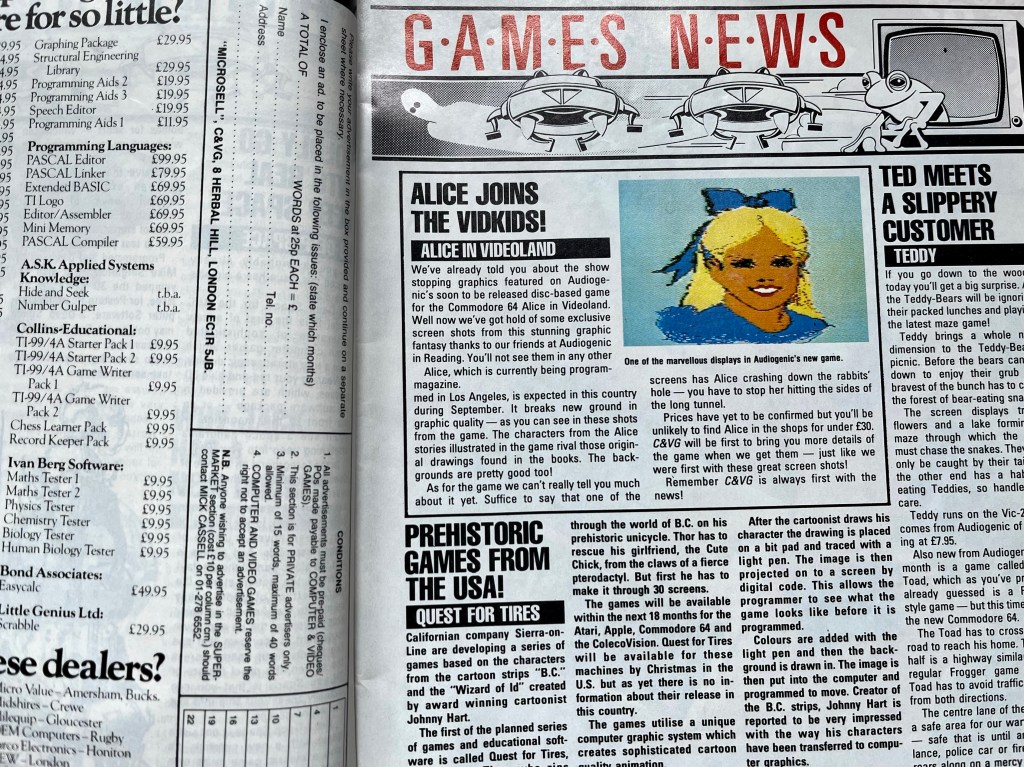
Right, we’re up to date, so the plan now is just to flick through the magazine together, check out its news, reviews, features and notable adverts, and I’ll pull out anything that catches my eye in the order it catches it. And speaking of eyes, you might want to grab a pair of 3D glasses for this one! Actually, I was amazed that for my relatively bargain price for this, it came with the original blue and red cardboard glasses, and they’re absolutely pristine! I’ll come back to all that when we get to type-ins because it’s not just pretty 3D artwork we’ve got to look at here either! For now we’ll start with the news, although the majority of it seems to be free publicity for Rabbit Software’s arcade “copies” like the “sophisticated, complex and challenging” Joust or Paratrooper for the 16K Spectrum, which is described as loosely based on Space Invaders but I reckon sounds just like Commando Raid from 1982 for the Atari 2600, or even Sabotage on the Apple II that in turn inspired that. There’s also the “showstopping” graphics on the upcoming Commodore 64 game Alice in Videoland to admire, a first look at Sierra’s B.C.’s Quest for Tires, and, best of all, a picture of a bloke called Jim who was the first person to complete Manic Miner and won a brand new TV for his efforts!

In the charts this month, Jet-Pac is deservedly topping the top ten for the Spectrum, while Space Raider leads the way on the ZX81, Arcadia (inspiration for the name of the site you’re reading!) is tops on the VIC-20 and Donkey Kong (official not a copy or kopy) on Atari 400/800. I’m never quite sure if it was Arcadia or Crazy Kong (incorrectly listed as Krazy Kong here but it was all very confusing!) that was the very first game I bought for my VIC-20, making it the very first game I ever bought full-stop, but it’s wonderful to see them both listed here, as well as Catcha Snatcha, which I think was the very first VIC-20 game I ever played at a friend’s house! Also of note there’s the aforementioned Manic Miner, Horace and the Spiders and Football Manager on the Spectrum, with the latter also appearing on the ZX81, which I had no idea even existed until I read this! And while the Wild West for arcade clones continues unabated elsewhere, Atari owners are spoilt for choice, with proper conversions of every stone cold classic you could ever wish for filling the entire top ten!
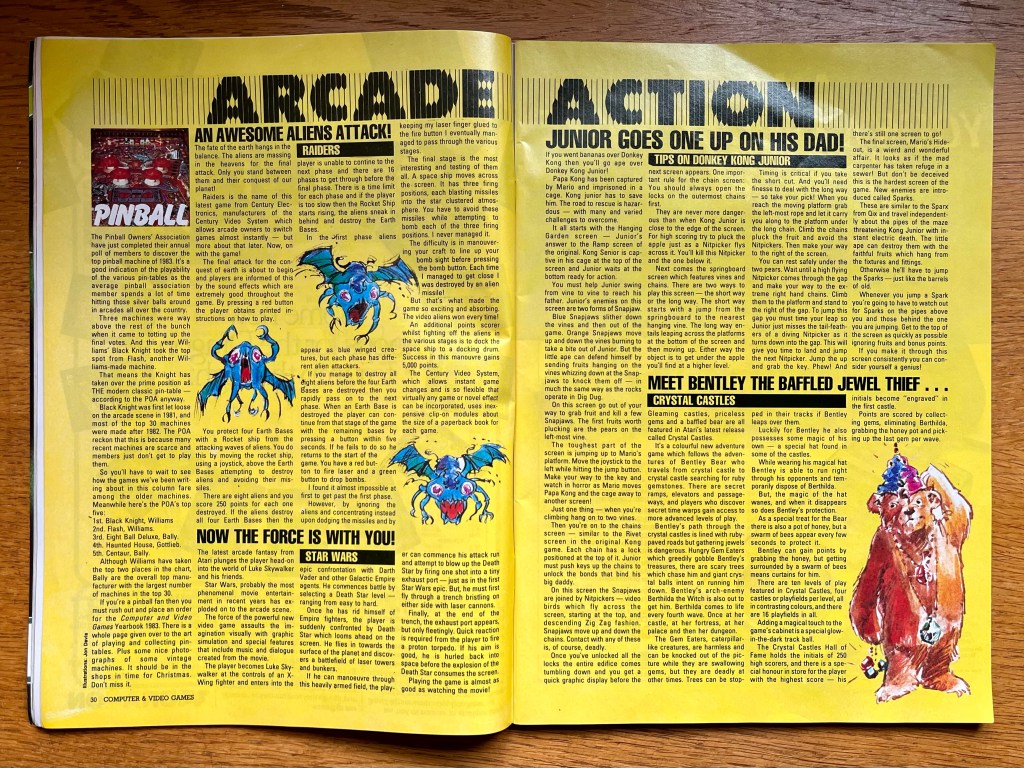
Over in the arcades, there’s news of what would soon become the most exhilarating thing I’ve ever experienced in a video game to this day, the timeless vector-graphics masterpiece in a sit-down cabinet, Star Wars from Atari. So immersive, and such a perfect representation of the climax of the movie, with all the sights and sampled sounds, and the authentic X-Wing flight-stick… Wow! Doesn’t stop there either, with both Donkey Kong Junior and Crystal Castles making first appearances, and that kind of thing is exactly the reason I wanted to start sharing this stuff, because there are no video gaming time capsules quite like this! And on that subject, I’ll get onto reviews for the month in a second, but they (as well as related news and features) are generally split into two totally separate categories, with “video gaming” covering home consoles such as Atari 2600 and Colecovision, while “software” covered the increasingly more common home computers.
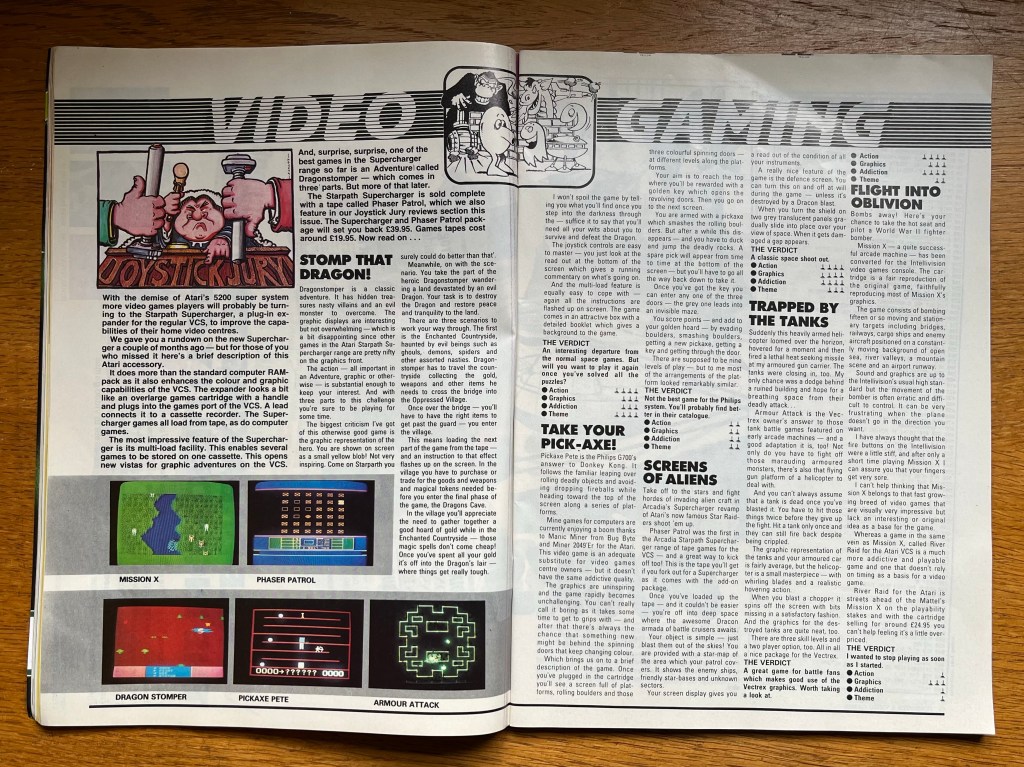
And with that, let’s take a quick look at those “video gaming” reviews, which this month focus on something I’ve never even heard of before, the Starpath Supercharger peripheral for the Atari 2600, or VCS as it was more commonly known at the time. We’re told that following the “demise of Atari’s 5200 super system” this is what players will be turning to improve the capabilities of the regular VCS. It’s an expander that plugs into the console’s cartridge slot, and, as well as boosting RAM, colour and graphics performance, allows you to plug in a cassette player to multi-load either individual games from a single cassette, or experience expansive new graphic adventure games such as this month’s headline act, Dragonstomper! Unfortunately, all that excitement soon fades as we learn the adventurer here is still just a yellow blob, and rest is simply “interesting” rather than supercharged! Even less interesting is Pickaxe Pete, another Donkey Kong clone for the Philips G700 (which I’ve also never heard of!), and then there’s a terrible take on River Raid for Intellivision called Mission X, and an intriguing tank battler called Armour Attack for an even more intriguing new machine called the Vectrex, which we’ll also come back to later!
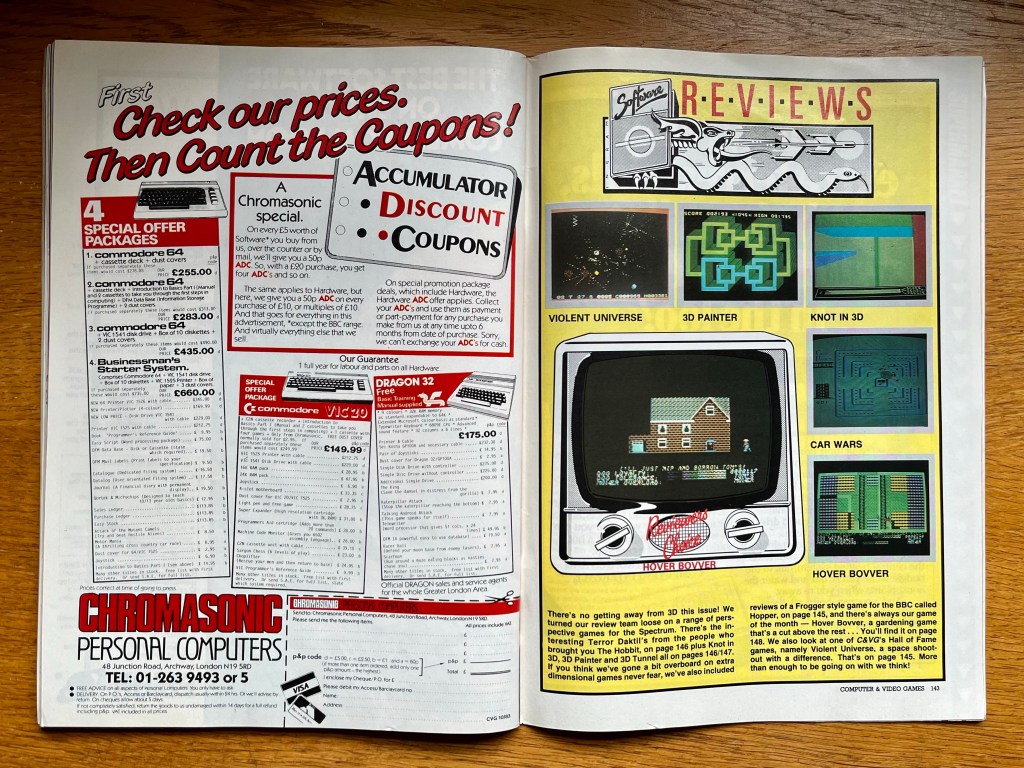
Over on the home computers, the still-mighty arcade-mower Hovver Bovver on the Commodore 64 gets justifiable game of the month treatment, while spectacular but ultimately very simplistic prehistoric pseudo-3D shoot ‘em up Terror Daktil is the highlight on the Spectrum, scoring big on graphics to impress your friends with but not much to keep you going long-term. Anirog’s Krazy Kong (as opposed to Crazy Kong from Interceptor Software earlier, as opposed to Krazy Kong from Interceptor Software…) caught my eye on the VIC-20 because I was close to buying that several times after getting the other one but it seems like I dodged a bullet – when a magazine is telling you the animation is terrible even for a VIC-20 you know to stay away! I’ll finish with Hopper, a decent version of Frogger for the BBC we used to play at school which, even at the relatively steep £9.95 asking price, is commended in particular for its “remarkably good value!”
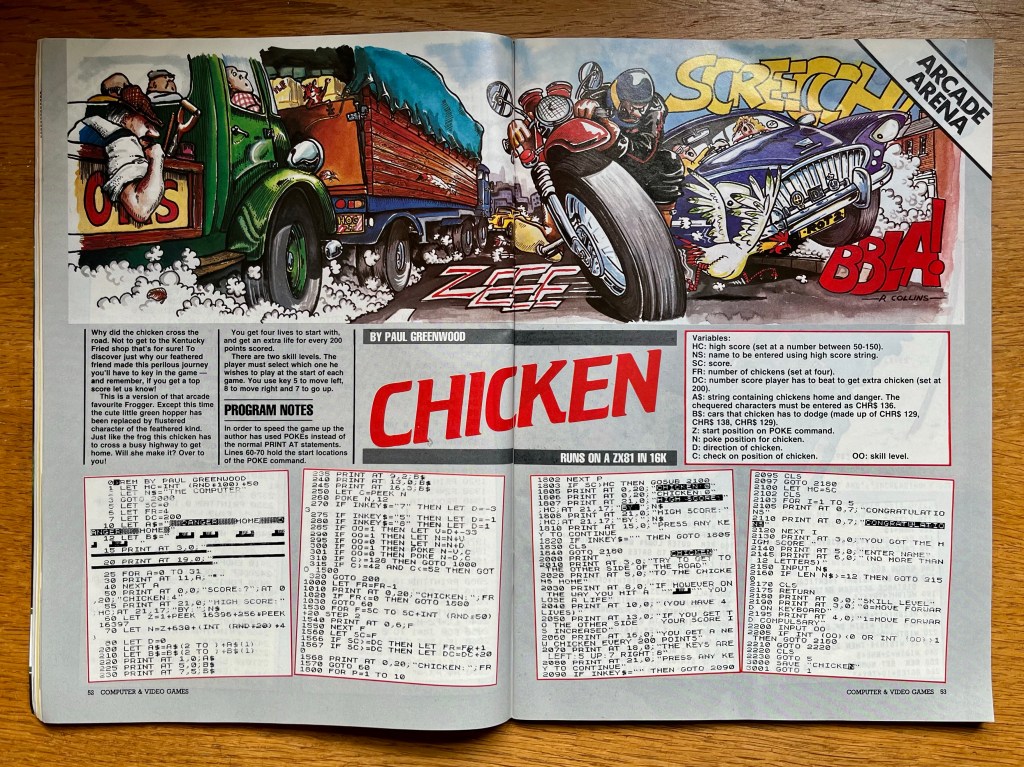
Now it’s time for that stalwart of the computer games magazine in the early- to mid-eighties, the type-in, and as mentioned earlier, there’s some very special ones to look at among the no less than fourteen of the things here this month! Let me give you the rundown on the regular ones first though, starting with some simplified takes on some very familiar arcade games by way of BBC Invader for the BBC, Chicken for the ZX81, and Light Cycles for the Dragon 32; the best thing about these is that like all the great clones (even if these aren’t quite that) you know exactly what you’re getting from them! There’s also a cool ski game, Slalom for the Texas TI 99/4A, the self-explanatory Duckshoot for the Atom, space catch ‘em up Stardust for the Apple II, maze game Escape From The Bastille (complete with full-screen guillotine!) for the Sharp MZ80K, pyramidic adventure Venture 16 for the Spectrum and Logjam for the Atari 400/800, which is pages and pages of BASIC plot and position commands resulting in a very nice log-pulling tow-boat game!
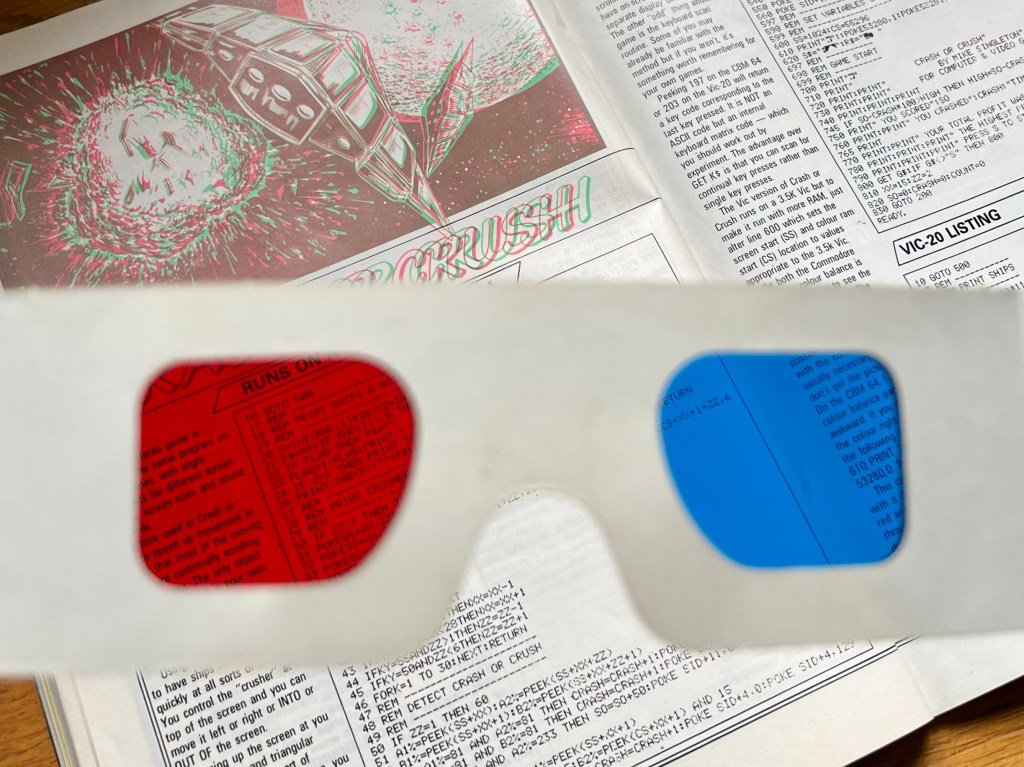
Time to grab those 3D glasses now because the rest of this month’s type-ins are not only about to literally leap out of the screen at you but are all coded by none other than Mike Singleton of The Lords of Midnight fame! After an explanation of how stereoscopic 3D works, there’s a really fascinating insight into doing things like displaying two distinct pictures to create the effect on all the different popular computers of the day, which is compounded by the need for “pure” blues and reds, that’s all well and good on the BBC or C64 but much trickier with the blues converging on blacks on the Spectrum, although as we’ll find out, there’s always a means! The listings here cover the BBC B, the Spectrum, the Atari, the Commodore 64 and the VIC-20, each one designed primarily to be fun while also delivering a decent 3D effect through your free glasses, but also accompanied by extensive program notes to make sure you are able to try programming your own 3D glasses games if you so desire. Which I definitely would have, so let’s have a quick look at each one!
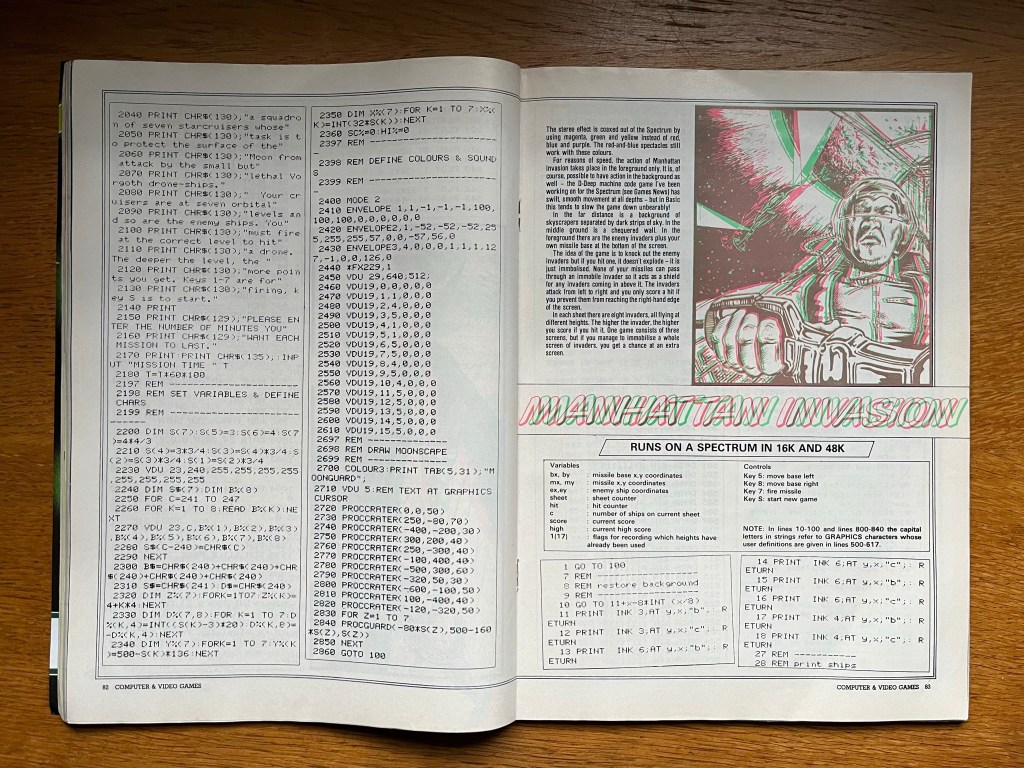
By the way, if you don’t fancy typing all this stuff in (which I definitely did!) there’s also a cool 3D picture to look at through your glasses for every one, so no one’s missing out on this pinnacle of eighties entertainment! Anyway, first 3D type-in if you’re up for doing that is Moon Guard for the BBC, a space shooter that dives right into madcap 3D with this strobe-like colour reverse effect when you hit an enemy that involves simultaneously turning black to purple, purple to black, red to blue and blue to red to preserve the sense of depth. And it’s a type-in!!! Over on the Spectrum, there’s more space invading with Manhattan Invasion, although obviously it wouldn’t be the Spectrum without a bit of magenta, green and yellow instead of blue, red and purple but fear not, the glasses still work all the same! Space-Hog on the Atari creates a two-level mountain range for your kamikaze pilot to crash his plane into other spaceships in-between, while finally for both the VIC-20 and C64 there’s more crashing in Crash or Crush, spectacularly described as an interstellar Steptoe and Son, where you have to catch bits of junk ships in the arms of your space crusher. This one’s cool because it uses some clever “poke” tricks to speed up the BASIC code while also presenting the stuff you’re trying to grab at different depths. Can’t believe I was only a few months out from getting my VIC-20 at the time or I’d have been all over this!

Always great to see the adverts that were starting to fill these magazines around now, transitioning from very dry “buy your computer here” or classified-style game listings to full-colour, double-page beasts that always looked great on your bedroom wall, so it’s also great to see them still intact in my new copy of this particular issue! Anyway, I’m going to start a rundown of a few notable ones with that brand new “video gaming” console we heard about earlier that goes by the name of the Vectrex from Milton Bradley! While never as exotic as the PC-Engine or as unobtainable as the NeoGeo, the Vectrex had that kind of allure all the same, with its built-in display offering infinite resolution and what looked like a mini arcade stick controlling near-perfect conversions of stuff like Scramble and Pole Position… Well, near-perfect in a very Vectrex way!
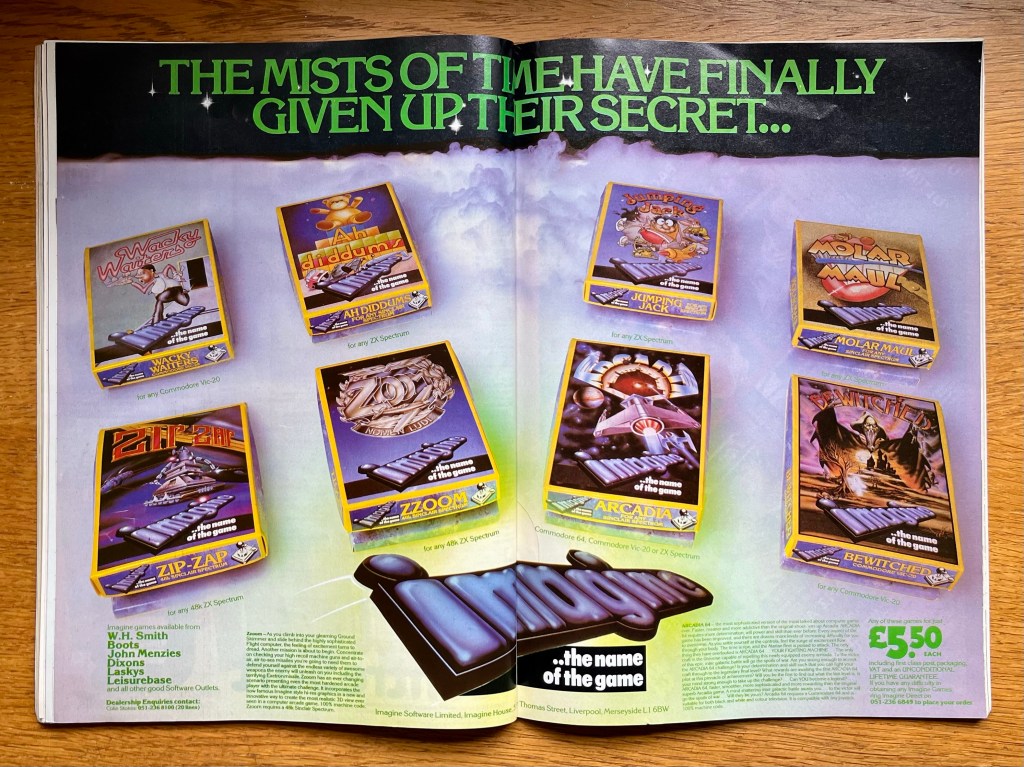
Apart from that, Imagine are going all-out with a big-budget spread for a bunch of mostly Spectrum and VIC-20 with a dash of Commodore 64 classics like Arcadia, Wacky Waiters, Molar Maul and Ah Diddums, while on the very next page Ultimate are marginally more subdued with their early Spectrum classics Jet-Pac, Pssst, Tranz Am and Cookie. Also more subdued than would be the case later, we’ve got the infamous Cassette 50 compilation for most systems, offering fifty games of mostly questionable quality, which I can also say first-hand was also the case for the calculator watch that would be given away with it in its heyday! As well as lots of different Kongs, Frogruns, Road Frogs and Hoppers, a Missile Defence and a Moon Hopper for the Dragon 32, Dig Dog for the Oric-1 and C64 caught my eye as the best-named of the arcade clones!
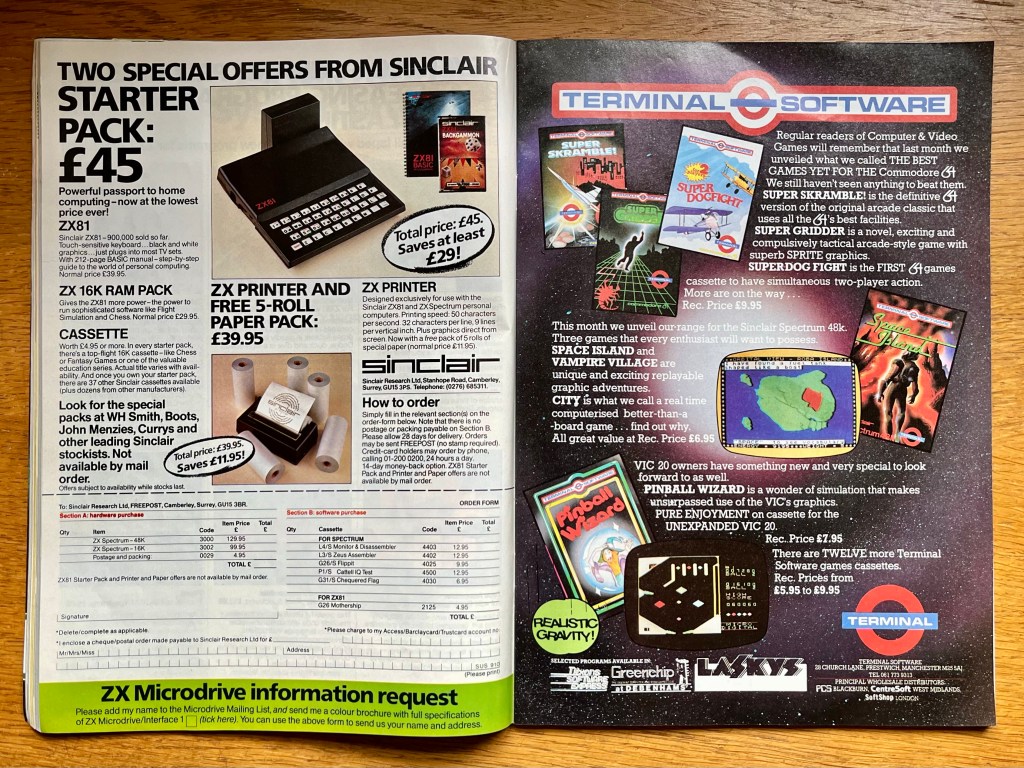
Always nice to see my old VIC-20 favourite (and the first game I ever covered here) Pinball Wizard also getting some advertising space, but I think we’ll finish with the adverts there and finish with a quick mention of a few other features… That said, it’s actually hard to find them hidden among dozens of pages of those dry classifieds I just mentioned! One of my favourites, as a victim of many a non-working type-in games listing, is Bug Hunter, which fixes a page full of mistakes from previous issues! There’s also various programming guides, from creating exploding sprites to getting into machine code, as well as the regular couple of pages on adventure games, including the Scott Adams-esque text adventure Temple of Bast for the TRS-80 and Mad Martha, where the system isn’t specified but it sounds like it could do with its own entry on the Bug Hunter pages! And I reckon that’s a good place to end this time, so I hope you enjoyed it and keep an eye out for loads more of these in the near future!

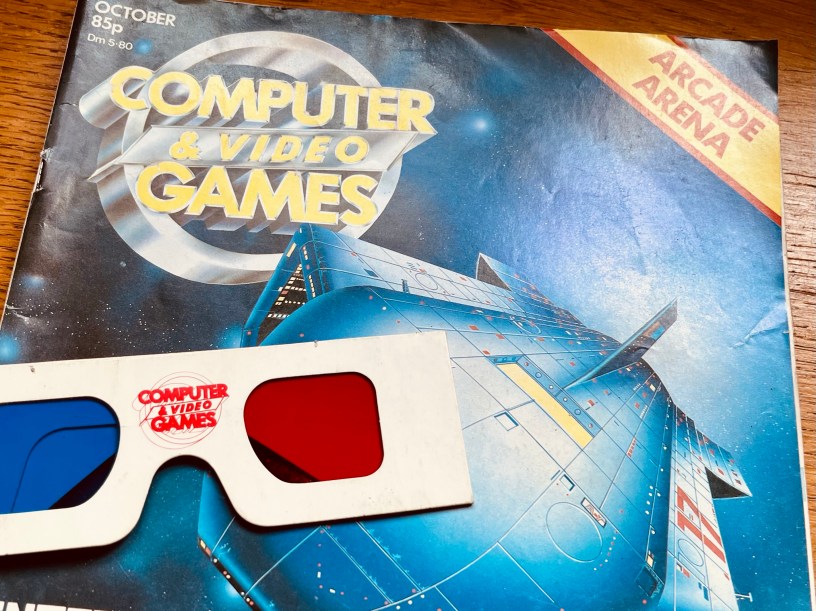
I, too, love reading through old magazines and have been doing so with my childhood Nintendo power collection. Great memories!
LikeLiked by 3 people
Awesome! Me too! Glad you enjoyed it.
LikeLiked by 1 person
With this blog you can fully understand that desires and demands, bring in all sorts of things confidential. Used computers in Kenya
LikeLike
Embrace the future of learning with Blooket Join. blooket join
LikeLike